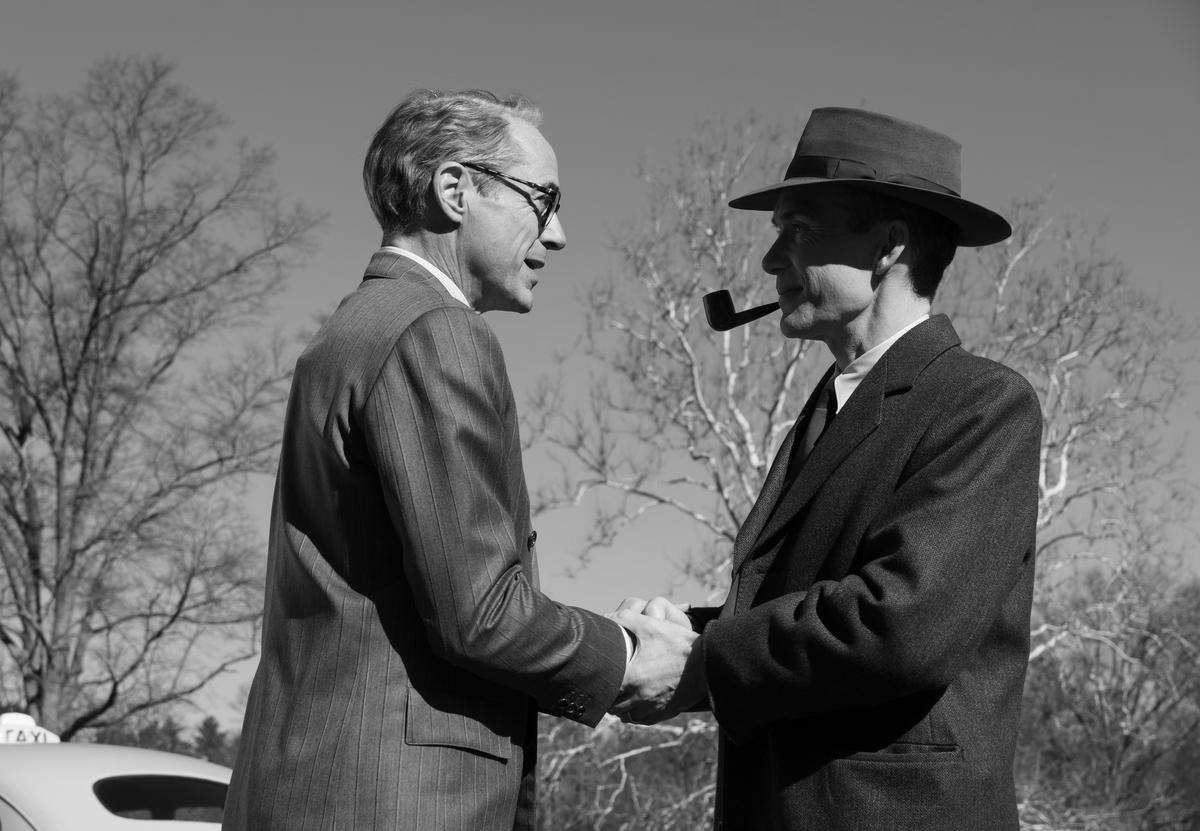Christopher Nolan’s place in modern cinema is fascinating. On the one hand, his fans adore him for his ambition, complex plotting, conceptual storytelling, and adept cinematic elements. Whereas his critics view these elements in a more negative light: ambition becomes ‘pretense,’ complexity becomes ‘convoluted,’ the concept becomes ‘emotionless,’ and polished technique becomes an ‘artless superficiality.’ What’s undeniable, however, is the significance Nolan holds as a filmmaker. Even with one of the most star-studded casts in Hollywood (where the likes of Robert Downey Jr. and Matt Damon step down from their usual leading roles to play supporting characters), Nolan’s most recent venture, Oppenheimer, which feels like a horror film, fills up theatre seats primarily due to his name, and that’s substantial.
There’s an apparent fascination surrounding his work, and Oppenheimer is an oddity compared to the rest of Hollywood because it forgoes many commercial tendencies. It’s a 3-hour-long character study of “The Father of the Atomic Bomb,” almost entirely dialogue-driven and scattered with abstract qualities. This challenging film evidently isn’t made for everyone, and yet almost everyone goes to watch it. Examining Oppenheimer is interesting, not only because it’s tough on both the filmmakers and the viewers alike, but how it fits into Nolan’s oeuvre. A closer examination of the film can help explore Nolan’s current and arising filmic interests. This essay focuses on a selection of aspects at the heart of Nolan’s work, namely his conceptual storytelling and rhythmic experiences. Additionally, it also explores the tone of horror that’s been implemented in his most recent films.
Nolan’s Fixation on Concept and Oppenheimer’s Contribution to it
The concept has always been at the heart of Nolan’s films. It’s often his central motivation and most notable trademark. From the misty memory of the unreliable narrator in Memento to the labyrinthine dreamscapes in Inception to the head-spinning time dynamics of Tenet, conceptual storytelling fills Nolan’s oeuvre from beginning to end. And though this may seem shallow to some, something about how Nolan presents this obsession has always engaged me.
Oppenheimer sees Nolan operating within the seemingly restrictive framework of the biopic but still on equivalent if not greater, conceptual heights than any of his previous films. After all, J. Robert Oppenheimer is equally a concept as he is a man. His title, “American Prometheus,” given to him in the book by Kai Bird and Martin J. Sherwin of the same name, is as fitting as ever. Even Nolan references the pertinent Greek allegory at the start of his film, immediately elevating Robert’s life to a mythological status, which is apt for the film’s perception of him: “You’re not just self-important, you’re actually important,” says Ernest Lawrence to Robert.

Fundamentally, Oppenheimer can be viewed as another retelling of the age-old story of man’s hubris. Except this time, the hubris leads to not just Robert’s emotional deterioration but the endangerment of the whole world. So the point of conceptualization exists where Robert’s actions reach the infinite potential of affecting every human being (not just in the present, but into the future too) – the chain reaction, as it is referred to in the film.
Robert’s passion for scientific discovery, showcased in a montage of atomic activity near the film’s beginning, functions alongside his hubris to motivate him to conduct The Manhattan Project. But once the consequences of the project become clear (after The Trinity Test and the bomb’s first use in Hiroshima), these somewhat triumphant sentiments transform almost entirely into fear and guilt: two palpable emotions that capture not only the immediate impact of the bomb but also its future repercussions.
Hence, Robert undergoes endless psychological torture that parallels Prometheus’ recurring physical suffering. And as Robert’s exterior is of equal significance, the subjective interiority here coexists with the comparatively objective political environment – color and black-and-white, concept and reality, fission and fusion.
In this way, Robert’s character study becomes a conceptual study grounded in reality. It carries the same, if not greater, philosophical weight than the likes of Interstellar and Tenet, but all this substance is concentrated in one person rather than some ostensible premise. So, the sensations that Nolan evokes here are all the more haunting. Looking back at all the times Nolan has situated tortured professionals in conceptualist stories, there’s perhaps no better director for this film. Indiewire’s review puts it well: “If Robert J. Oppenheimer didn’t exist, Christopher Nolan would have probably been compelled to invent him.”
Exposition, Politics, and Scientism: How Nolan’s Tendencies Form Cinematic Rhythms
Nolan’s exposition can be easily critiqued as clumsy and uninteresting when viewed as a detached element. However, despite the supposed clunkiness in Nolan’s dialogue, something about how he handles this in his previous films has always worked for me. Inception is a film where much of the runtime is spent explaining the rules of the dream world and ideas like limbo. It alternates primarily between exposition and action set-pieces, forgoing any character development or emotion until the very end. And though this is bound to disengage many viewers, the way in which the climax releases emotion has always satisfied me.
Read More: Why Oppenheimer Will Go Down As One of The Most Defining Films Of Our Era?
During the third act, when Saito is lost in limbo, everything seems to have failed until Ariadne chooses to follow him. Then, the plan (which was painstakingly designed across the whole film) works out, and a simulated yet effective catharsis is achieved when Fischer opens the vault (Cillian Murphy’s acting here is notably remarkable). In particular, the most impactful moment of the film for me was Cobb bringing back Saito from limbo and then waking up to discover that his sense of reality remains unaltered. Here, the logic of the dreamworld is momentarily relinquished for the sake of sheer belief; the psychological outcome of limbo is entirely uncertain (and pessimistic based on previous exposition regarding Cobbs’ wife), so such a triumphant finale is powerful.
Similarly, Tenet is nothing but a stream of arbitrary exposition and action sequences that lead to a sensory overload and a release of humanist emotion. On the other hand, Interstellar relies more on its cosmic wonder and intense melodrama, even though Nolan’s curiosity about astronomical concepts is evident in its script. The catharsis in Interstellar’s climax is somewhat comparable to the aforementioned scene from Inception. Here, Cooper enters Gargantua (the black hole shown in the film) and shifts past events by contacting the younger version of his daughter.
Many have labeled this moment as pseudoscience, but such a viewpoint, regardless of the validity of the theory behind it, fails to acknowledge what is achieved narratively – Nolan allows Interstellar to lean into pure abstraction (emphasized by the four-dimensional imagery of the tesseract) and he pushes the central father-daughter relationship to a sentimental apex. Despite having the most hermetically sealed plotting Nolan has worked with, Tenet amplifies a similar sensation by forgoing any conventional establishment of story elements and becoming an abstraction in its entirety. In all of these works, Nolan’s most unforgettable moments lie not where he obsesses over the mechanics of his creations but where he chooses to withdraw from this very position.
Oppenheimer builds on this aspect of Nolan’s oeuvre but through various filmic components that are strikingly different from his previous works. Unlike Inception, Interstellar, or Tenet, there is little to no action and explicit sentimentality. Instead, Oppenheimer engages primarily through a combination of snappy dialogue and sharp editing, with Ludwig Göransson’s wonderous score complementing both of these. The first film that comes to mind when such a mixture of elements is mentioned is The Social Network, and Nolan’s script here has more in common with those of Aaron Sorkin than his own. In particular, the hasty wit in Oppenheimer’s depositions feels incredibly similar to those from The Social Network, with the back-and-forth editing structure in both films emphasizing this correspondence.
Two other films that also come to mind are JFK and Zodiac, which feed the audience with an unending stream of information over several years, constructing an intense curiosity surrounding a mysterious case. In the former, Oliver Stone’s form has an unmistakable paranoia that infuses the dreamy, colored reality and the archival black-and-white footage. Nolan’s take on America’s military-industrial complex in Oppenheimer is relatively (and expectedly) polished, forgoing any visual texture for his usual sterility. And though this is another common critique of his work, Nolan’s tonal approach to his subject matter fundamentally differs from that of Stone. In JFK, Stone continuously depicts American agencies in a suspicious light, removing the illusive pillars of stability that prop up the nation. Oppenheimer is comparatively moderate in its critique, which has understandably fostered a debate surrounding the film’s moral ambiguity.

Nolan chooses not to showcase the Japan bombings or its sickening consequences. Photographs of the latter were implicitly viewed by characters in one scene but hidden from the audience, much like how images of the event were suppressed in post-WW2 USA. Furthermore, scenes leading up to the construction of the atomic bomb feel conflictingly enthusiastic, which is not at all surprising for a director who gave us the triumphant sensations of The Dark Knight trilogy and Dunkirk. But all this, in addition to the relative tonal neutrality compared to JFK, works well to reflect Robert’s emotional state at the time as well as the scientism in his community – a vigorous passion for discovery and advancement obscurely merged with militaristic motives.
Read More: Why Oppenheimer is Christopher Nolan’s Best-Directed Film Yet?
Furthermore, Nolan’s conceptual obsessions come with a strong admiration for physics, so his films often appeal to those who primarily view his works as a representation of science. There’s a supposed rationalism to his narratives (despite the previously discussed abdication of mechanics in Inception, Interstellar, etc.), accentuated by the cold aristocratic manner in which his characters are presented, from the James Bond-esque spy style in Tenet to the affluence of academia in Oppenheimer. Despite the problems such a tone can bring about in genres outside sci-fi (Bush-era politics in The Dark Knight is an interesting case of this), Oppenheimer, intentionally or unintentionally, imbues these sensibilities into its hurried rhythms.
Also note that for such a lengthy runtime, Nolan still rushes over multiple story beats, but this is simply another component of the editing patterns constructed for the sake of experience as opposed to conventional narrative structure. To consider Nolan’s works solely as character studies or exhibitions of concept is a misstep because the essence of his technician-like filmmaking lies in the steady mesmerism it fosters. Oppenheimer exhilarates during scientific deliberation and military procedures, only to bring everything to a halt when the imminent horror of these activities is realized.
The way we fixate on Nolan’s mechanics and musings feels comparable to the manner in which Robert and his fellow scientists conform to American militarism. As the nationalistic marching of feet gets louder, we helplessly spectate the insurmountable ‘progress’ that eventually leads to disaster. Robert’s psychology is intricately constructed, to say the least, with his hubris-led heroism and victimization at the hands of a McCarthyite court conflicting with his cowardly compliance and infidelity, but all of this seeps into the cinematic cascade.
It’s all ruminations on individual and collective experiences that build up to a pinnacle of existential guilt and fear. Nolan involves us in this complicated intersection of the military-industrial complex and Western scientism, only to uncover the hellish dread hidden beneath it.
Existential Horror in Oppenheimer and Nolan’s Emerging Interests
With the exception of horror, Nolan’s work in the 2000s and early 2010s can be classified under a number of overlapping genres. Perhaps some early sequences in Batman Begins could contradict this. Still, that film seemed to be significantly influenced (and maybe confined) by the titular character’s mythology as opposed to any genuine interests in horror Nolan may have had.
For me, Dunkirk was Nolan’s first film, which was unmistakably imbued with horror; in particular, the moment when a torpedo sank a British ship evoked an unrelenting claustrophobic anxiety. The sheer tangibility that Nolan’s clean, impressionistic IMAX images have when he collaborates with Hoyte van Hoytema helps to optimize this sensation. Additionally, Hans Zimmer’s pulsing score and the constant invisibility of German soldiers (until the very end) also enhance the fiercely gripping experience.
His next film, Tenet, has an existential dread in the sense of inescapability inherent to a concept like time inversion. However, an aspect that goes under-discussed here is the cosmic horror present in many scenes. Consider the first time the protagonist and Neil encounter a turnstile (an object that already seems mechanically unsettling). “There’s someone here with us,” says Neil in the words of a monster movie character.
Eventually, a reverse antagonist jumps out of the turnstile and starts fighting the protagonist. Besides the alien aura that his hefty black gear carries, the backward jumps and crawls felt distinctly unnerving here. And just like how Zimmer’s music complemented Dunkirk, the disquieting reverse sounds and nerve-shredding synths in Göransson’s score are equally as haunting (‘RED ROOM BLUE ROOM’ and ‘SATOR’ are a couple of suitable examples of this).
Oppenheimer forgoes Tenet’s peculiarity but expands on its existential horror – At the end when Robert envisions a globe engulfed in the flames he initially generated, any notions of redemption are stifled entirely by the all-encompassing system of cause and effect. Cillian Murphy’s wide-eyed expressions give form to this astronomical pain concentrated in one man. But Oppenheimer also sees Nolan entering the realm of Lynchian horror, utilizing strange sound design and blinding lights in the film’s subjective sequences, most notably when Robert speaks in front of a patriotic crowd.
Here, Robert walks to the podium placed under a basketball hoop, an almost sardonic example of absurd imagery in its own right, before giving his speech and hallucinating the screams and severed skin from the Japan bombings. Although these moments lack the texture and panache of Lynch’s works, Nolan manages to show a side to his filmmaking that I considered non-existent before.
Oppenheimer accrues the weight of Nolan’s filmography, from his cogitations on the concept to his rhythmic musicality, and allows him to partially extend into the horror genre. Though opinions will vastly differ on what’s his best film, this is by far the most politically pointed and probing work we’ve seen from Nolan. His niche is now well-formed, and hopefully, with future works, he will continue to experiment with different genre templates and lean further into the enrapturing beats of his procedures.







